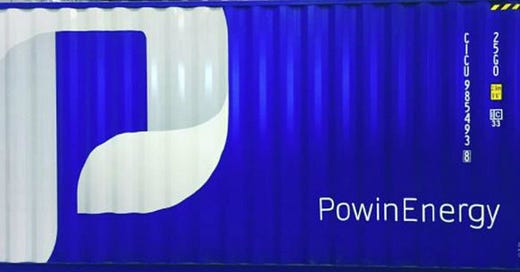S1.C71. TELL ME WHY - Powin
BY PHUONG ANH - Powin, once a global battery storage leader, now faces potential shutdown due to unforeseen financial strain, policy shifts, and overreliance on foreign supply chains.
In a dramatic turn of events, Powin LLC, once a leading player in grid-scale energy storage based in Tualatin, Oregon, is facing potential shutdown. The company recently issued a layoff notice indicating that up to 245 employees—including 96 in Oregon and 149 remote workers—could lose their jobs if its business conditions do not improve by July 28, 2025. This development marks a surprising downfall for a company that had seen rapid growth and was considered a global leader in energy storage innovation.
Founded with a vision to accelerate the transition to clean energy, Powin built its business by integrating Chinese-manufactured lithium-ion battery cells with its own proprietary system technology. This combination enabled it to provide grid-scale energy storage solutions that were both cost-effective and scalable. The company's strategy aligned with global shifts toward renewable energy, and it quickly became a key supplier in the U.S. and international markets. Private equity firms recognized Powin’s potential early on, injecting over $235 million into the company since acquiring a controlling interest in 2021.
Despite its momentum, Powin’s success proved vulnerable to external shocks and policy shifts. In the WARN Act notice submitted to state and local officials, the company cited "unforeseen business circumstances" and noted that the broader economic and regulatory environments remained “dynamic and fluid.” This vagueness belied a storm of complications threatening the viability of not just Powin, but other clean energy startups caught in similar crosscurrents.
Among the key contributing factors to Powin’s precarious position is the shifting landscape of U.S. trade and energy policy. The Trump administration’s tariffs on Chinese imports, including battery cells, significantly raised operating costs for companies like Powin that relied on international supply chains. Furthermore, the potential rollback of renewable energy incentives—programs crucial to keeping clean energy projects economically competitive—has dampened investor and consumer confidence. These developments came at a time when the energy storage sector was expecting robust support from the Biden administration’s push for green infrastructure. Yet, delays in domestic battery manufacturing initiatives have meant that alternative supply chains were not ready in time to offset the policy headwinds.
In a 2024 interview, Powin CEO Jeff Waters acknowledged the lag in domestic production, predicting that U.S. factories wouldn’t begin substantial output until late 2025. This timing mismatch has proven critical, leaving Powin with limited supply flexibility and squeezed margins as demand slowed and project pipelines dried up. The result is a company caught in a perfect storm: high capital costs, uncertain regulation, constrained supply, and volatile market demand.
Powin's potential collapse is particularly notable because it illustrates the fragility of even the most promising clean tech companies in the face of inconsistent political and economic environments. It also signals broader challenges for the energy transition—chiefly, how nascent green industries must navigate complex global supply chains, regulatory ambiguity, and fickle investor sentiment.
As Powin considers strategic options, including possible cessation of operations, it serves as a cautionary tale of how policy, supply chains, and timing can make or break even the most well-funded clean energy innovators. Its story underscores the urgent need for stable, long-term planning and support in building a resilient clean energy infrastructure.
Here are 3 questions for you :
"How resilient is our supply chain to geopolitical and policy shocks?"
Relying heavily on Chinese battery imports while tariffs loomed created systemic risk. A dual-sourcing or regional diversification strategy might’ve buffered impact.
"What phased approach can we take to scale without outpacing cash flow?"
Rapid global expansion without enough market cushion or localized production proved unsustainable. Could they have piloted key markets before wide-scale rollout?
"Do we have the financial runway to withstand delays in domestic manufacturing?"
Betting on domestic production ramping up “by late 2025” without bridging solutions or investor alignment created a timing gap that proved fatal.
Provide the question# on your comment when you answer.
READ MORE SCORE MORE
PREVIOUS
S1.C70. TELL ME WHY - Joann
·Joann, a long-standing American retailer known for its fabrics and crafting supplies, has filed for Chapter 11 bankruptcy protection for the second time in less than a year. Founded over 80 years ago, Joann’s latest filing reflects not just internal financial and operational mismanagement, but also a wider industry trend—traditional brick-and-mortar ret…
NEXT
if you have difficulties accessing any of these documents to read, please feel free to revert to us
Here is a quick guide if you want to change the article into languages of your choice…. but you already know this






